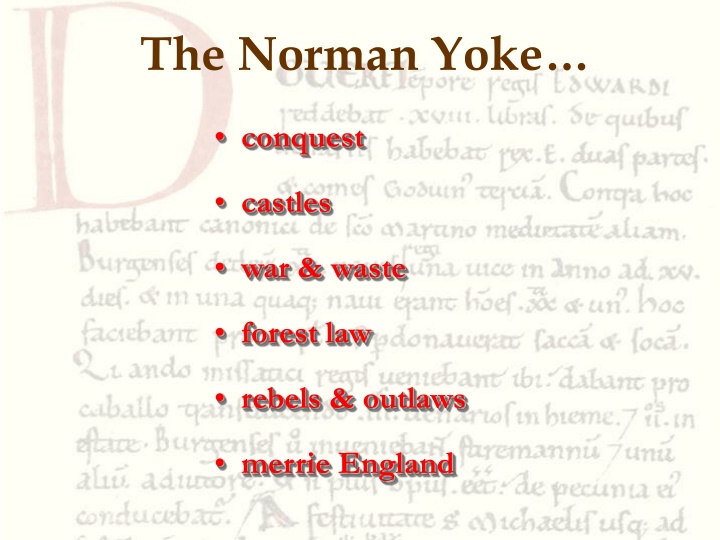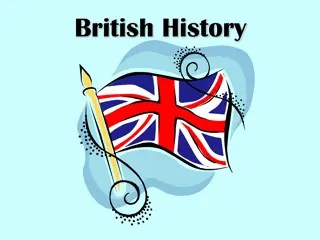
The Norman Conquest of England: Castles, War, and Genocide
"Explore the impact of the Norman Conquest on England, from the introduction of castles and war to the harrowing genocide in Yorkshire. Discover the history and consequences of this pivotal event in English history."
Download Presentation

Please find below an Image/Link to download the presentation.
The content on the website is provided AS IS for your information and personal use only. It may not be sold, licensed, or shared on other websites without obtaining consent from the author. If you encounter any issues during the download, it is possible that the publisher has removed the file from their server.
You are allowed to download the files provided on this website for personal or commercial use, subject to the condition that they are used lawfully. All files are the property of their respective owners.
The content on the website is provided AS IS for your information and personal use only. It may not be sold, licensed, or shared on other websites without obtaining consent from the author.
E N D
Presentation Transcript
The Norman Yoke conquest castles war & waste forest law rebels & outlaws merrie England
Hastings, 13 October 1066 The day England acquired a new royal dynasty, a new aristocracy, a new Church, a new language, a new
Harold killed Dover burnt
The Conquerors footprints Plotted by the destruction recorded in Domesday Book
Castles of the Conquest The castle was introduced into England by the Normans, who built them: far and wide throughout the country, and oppressed the wretched people (Anglo-Saxon Chronicle) It has been estimated that possibly 500 castles were built by the end of the eleventh century, an enormous capital investment; but fewer than 100 can be securely documented
Castles of the Conquest Domesday Book names the majority of those castles known to have existed by 1086
Castles of the Conquest Hastings Chepstow Ludlow Shrewsbury Chepstow
Genocide in Yorkshire The Conquest, the rebellions which followed the Conqueror's coronation, and the ferocity with which some were suppressed, laid waste large areas of England. The infamous harrying of the north between 1069 and 1070 was an act of genocide which left much of northern England uninhabited for a generation. One chronicler, Ordericus Vitalis, wrote of this harrying :
Genocide in Yorkshire He [the Conqueror] harried the land and burnt homes to ashes. Nowhere else had William shown such cruelty. In his anger he commanded that all crops and herds, chattels and food of every kind, should be brought together and burned to ashes with consuming fire, so that the whole region north of the Humber might be stripped of all means of sustenance. In consequence, so serious a scarcity was felt in England, and so terrible a famine fell upon the humble and defenceless populace, that more than 100,000 Christian folk of both sexes, young and old, perished of hunger
Genocide in Yorkshire The same writer says that this act haunted the Conqueror to his dying day. On his death-bed, he repented: I ... caused the death of thousands by starvation and war, especially in Yorkshire. In a mad fury, I descended on the English of the north like a raging lion, and ordered that all their homes and crops, and all their equipment and furnishings, should be burnt at once; and their great flocks and herds of sheep and cattle slaughtered everywhere. So I chastised a great multitude of men and women with the lash of starvation and, alas, was the cruel murderer of many thousands
Genocide in Yorkshire On the basis of recorded waste in Domesday Book, it has been calculated that 15 years after the harrying Yorkshire still had only 25% of the men and ploughs there had been on the day in 1066 when King Edward was alive and dead recorded waste in Domesday Book
Forest Law Forest law was another oppressive feature of Norman rule. One chronicler, half-Norman himself, described the death of two of the Conqueror's sons in hunting accidents in the New Forest as a just punishment for his excesses committed in the name of the royal sport of hunting: Now, reader, let me explain why the forest ... is called 'new'. That part of the country had been populous in earlier days ... But after William I conquered the realm of England, so great was his love of woods that he laid waste more than 60 parishes, forced the peasants to move to other places, and replaced the men with beasts of the forest so that he might hunt to his heart's content. There he lost two sons, Richard and William Rufus, and his grandson Richard ... by which the Lord plainly showed his anger (Ordericus Vitalis).
Forest Law Domesday Book shows many depopulated areas in what is now the New Forest, where the ploughs and peasants of King Edward's days had been replaced with royal forest by 1086 the New Forest in 1086
Rebels and outlaws Small wonder then that the forest features largely in myths of the Norman Yoke from the days of Hereward the Wake and Edric the Wild to Robin Hood These and other disinherited native nobles fought back against Norman tyranny from the shelter of the forests the Normans had created
Rebels and outlaws Edric the Wild - or Edric of the Woods was, like Robin Hood after him, a disinherited nobleman who took to the forest to fight Norman tyranny Edric the Wild features in many Domesday entries
Rebels and outlaws The origins of the legend of Robin Hood are unknown; but the Norman Conquest would provide the perfect setting
Unsurprisingly, nostalgia for the Good Old Days can be detected in Domesday as in this custom which made the Lady of the Manor happy
Fools and jesters one of two jesters named in Domesday (whose quips may have had a bitter edge)
Domesday Book All this, and much more, is recorded in Domesday Book, the single most valuable source for early medieval history ...... Domesday 1086 Domesday 2000
Domesday Book Domesday Book is a major source for the disciplines of: Archaeology Geography Genealogy Law Linguistics Onomastics Palaeography Philology Prosopography Topography
Domesday Book Domesday Book is known and studied world-wide. Scholars from the following countries have published significant work on Domesday Book: Australia Belgium Canada Denmark France Germany as well as the U.K. Holland Japan Norway Russia Sweden U.S.A. A complete bibliography of Domesday Book would probably number 10,000 publications
Thank you for watching
This powerpoint was kindly donated to www.worldofteaching.com http://www.worldofteaching.com is home to over a thousand powerpoints submitted by teachers. This is a completely free site and requires no registration. Please visit and I hope it will help in your teaching.





